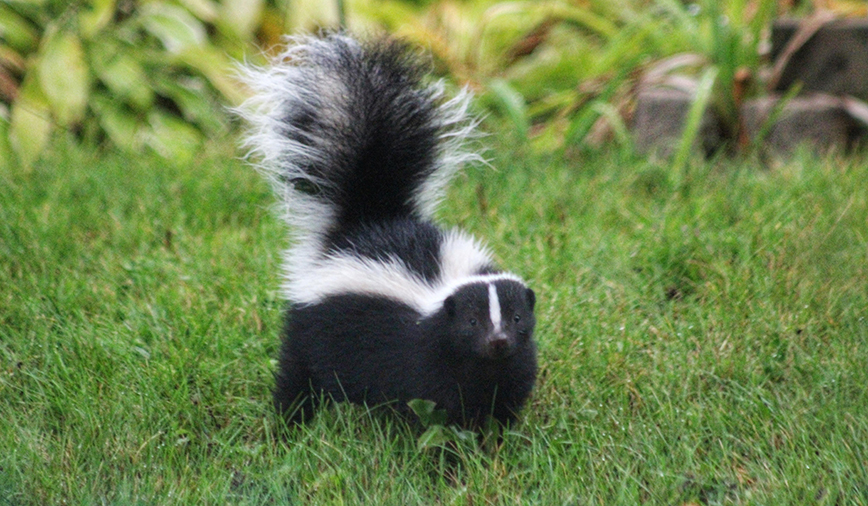My dad called the other day, and the news wasn’t good. He and mom were fine, he said, but there was a problem. A big problem. A big, stinky problem.
He explained that a skunk had decided to take up residence underneath their sun porch, and the odiferous evidence of its presence was wafting through the house, even as he spoke. I winced as I pictured my mom, whose sense of smell is a lot like a bloodhound’s, only better. Poor mom. Poor dad. Poor skunk!
You see, the skunk was only following its instincts which, this time of year, tell it to find an unoccupied space that’s quiet, dark and offers protection. In less developed areas, that space might be a burrow previously excavated by a woodchuck or a badger. But here in suburbia, it may well be the space underneath a raised porch or backyard shed. My parents’ yard, as it turns out, offers both.
“Yippee!” I’m sure the skunk thought. “Not only did I find a great spot to hang out this spring, but I’ve got a place to vacation this summer!”
Sad to say, this homesteading adventure ended badly for the skunk. A wildlife removal service was called, and the skunk was trapped, taken away and euthanized. This spring, countless other wild animals will meet with the same fate.
Why? Because we humans, in our desire to create the perfect habitat for ourselves, have as a consequence also created ideal habitat for lots of other creatures. Sure we’ve driven many away (when was the last time you had to stop to let a bison cross in front of you?) but many more have adapted to our human ways and have benefited immensely from the food and shelter we inadvertently provide.
As spring gets underway, more and more skunks—and opossums, raccoons, squirrels and chipmunks, to name a few—will be seeking new digs to in which to raise their young. Now is the time to check your home’s exterior for gaps near the foundation and eaves. Make those repairs you’ve been putting off, and seal off open spaces under decks, porches and sheds with heavy-gauge hardware cloth.
If you think something might already have moved in, stuff a wad of newspaper in the suspected entrance and leave it overnight. If it’s been moved the next day, you’ve got a new tenant. Whatever you do, don’t try to trap it yourself. Only licensed removal experts have the permits that are required to move animals. And ordinances prevent you from releasing any live animal in a park or forest preserve. Besides, these open spaces already have substantial populations of whatever critter you might have captured; adding another to the mix would only result in conflict and confusion.
A better plan is to first try and get the animal to relocate on its own. Make the “ideal habitat” less appealing. Bright lights and a loud radio often do the trick. There are also many deterrent chemicals on the market, although many of these must be reapplied frequently to remain effective. Should these tactics fail, call a wildlife removal expert. Then call a handyman, or make the modifications yourself, so the next animal that might want to move in will move along instead.
***
For what it’s worth, while I could appreciate my parents’ predicament, I was not-so-secretly rooting for the skunk. Consider these facts, and maybe you’ll become a skunk fan too:
• Insects make up as much as 70% of the skunk’s summer diet. Rodents figure in too. So if you think you’ve got too many bugs or mice around, a skunk just might help even things out.
• Most skunks give ample warning before spraying, and will hunch their backs, stamp their feet and shuffle backwards in a skunky sort of cha-cha before letting loose.
• A mighty squirt can travel up to 15 feet.
• After a defensive encounter, a skunk needs about a day to “recharge.”
• Starvation, parasites and viral infections take their toll on skunk populations in winter; fewer than half typically survive. Age two is old for a skunk.
• Our word skunk comes from the Abenaki word segongw, or, “one who squirts.” And then there’s the Latin name, Mephitis mephitis, “the stinkiest of the stinky.” How fun is that?!
***
Hey parents—looking for something fun for your kids to do over spring break next week? Check out these St. Charles Park District programs for ages 7 and up: Nature’s Lost & Found on Tuesday March 25; Secret Life of…Salamanders on Wednesday March 26; and Things That Make You Go Ewww! on Thursday March 27. All programs run from 1 to 2:30 p.m. and will be held at the Pottawatomie Community Center. For more info and registration information, visit www.st-charlesparks.org.
Pam Otto works for the St. Charles Park District and can be reached at 630-513-4346 or potto@stcparks.org.

